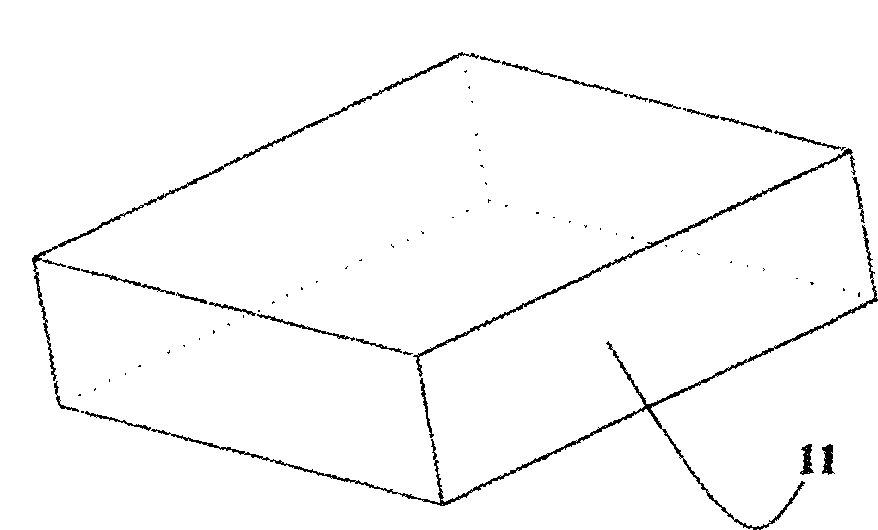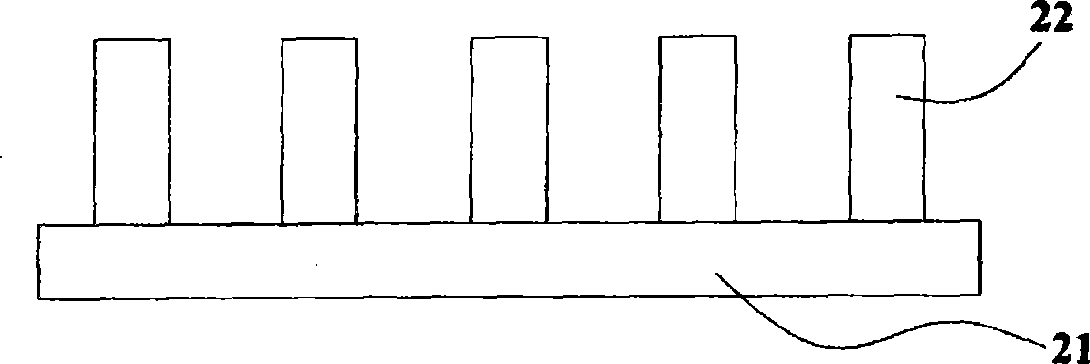Method for growing active area epitaxial wafer of nanometer folded structure
A technology of active regions and epitaxial wafers, applied in the fields of electrical components, semiconductor/solid-state device manufacturing, circuits, etc., can solve problems such as reducing internal quantum efficiency
- Summary
- Abstract
- Description
- Claims
- Application Information
AI Technical Summary
Problems solved by technology
Method used
Image
Examples
Embodiment 1
[0033] Embodiment one: see figure 1 - Figure 4. First prepare and obtain an AlInGaN material template 11; then prepare 1-1000 nanometer thick SiO on the AlInGaN material template by chemical vapor deposition method 2 、SiN x Dielectric film; then a layer of metal is deposited on the dielectric film, and the metal is aggregated into metal islands with a diameter of about 10-200 nanometers by rapid annealing. Using the metal island as a mask material, the AlInGaN material template is etched by ion beam etching and coupled plasma etching, thereby making an AlInGaN nano-column array 21, the nano-column array 21 includes a plurality of nano-columns 22; and then AlInGaN An active region layer 31 with a nanofold structure is grown on the nanocolumn array 21 and nanocolumn 22, and finally a p-type GaN layer 41 with a nanohole array 42 is grown on the active region layer 31 with a nanofold structure to obtain a LED epitaxial wafer with nanofold structure active region;
Embodiment 2
[0034] Embodiment two: see figure 1 - Figure 4. First prepare and obtain an AlInGaN material template 11; then prepare 1-1000 nanometer thick SiO on the AlInGaN material template by chemical vapor deposition method 2 、SiN x The dielectric film; then use the method of holographic exposure and electron beam exposure to make template pattern on the dielectric film; finally use ion beam etching and coupled plasma etching method to etch the AlInGaN material template, so as to make the AlInGaN nano column array 21, the The nanocolumn array 21 includes a plurality of nanocolumns 22; then an active region layer 31 with a nanofold structure is grown on the AlInGaN nanocolumn array 21 and the nanocolumn 22, and finally a belt is grown on the active region layer 31 with a nanofold structure. A p-type GaN layer 41 with a nanohole array 42 to obtain an LED epitaxial wafer with a nanofold structure active region;
Embodiment 3
[0035] Embodiment three: see figure 1 - Figure 4. First prepare and obtain an AlInGaN material template 11; then use laser scanning etching technology to etch the AlInGaN material template to make an AlInGaN nano-column array 21, the nano-column array 21 includes a plurality of 22; then the AlInGaN nano-column array 21 and nano An active region layer 31 with a nanofold structure is grown on the pillar 22, and finally a p-type GaN layer 41 with a nanohole array 42 is grown on the active region layer 31 with a nanofold structure to obtain an active region with a nanofold structure LED epitaxial wafers;
[0036] Use case one: first see figure 1 -As shown in Figure 4, a layer of 1-10 micron thick n-type AlInGaN epitaxial layer is epitaxially grown on a sapphire substrate by metal organic chemical vapor deposition (MOCVD), wherein the composition values of Al, In and Ga can be adjusted is any value between 0-1, and the AlInGaN material template 11 is obtained. Secondly, the A...
PUM
 Login to View More
Login to View More Abstract
Description
Claims
Application Information
 Login to View More
Login to View More - R&D
- Intellectual Property
- Life Sciences
- Materials
- Tech Scout
- Unparalleled Data Quality
- Higher Quality Content
- 60% Fewer Hallucinations
Browse by: Latest US Patents, China's latest patents, Technical Efficacy Thesaurus, Application Domain, Technology Topic, Popular Technical Reports.
© 2025 PatSnap. All rights reserved.Legal|Privacy policy|Modern Slavery Act Transparency Statement|Sitemap|About US| Contact US: help@patsnap.com



